Virginia is one of those states that are blessed with stunning landscapes. That’s why it’s home to an abundance of awe-inspiring and majestic wildlife, especially the birds.
As a matter of fact, it’s believed that there are over 400 species of birds in Virginia alone. That’s almost every single bird species found on the entire Eastern seaboard.
We rounded up a list of some of the most popular birds you’ll likely come across in the great state of Virginia. You’ll read about birds of different sizes, colors, and other unique features.
So, without further ado, here are the most common 30 birds in Virginia.
Red Birds in Virginia
Northern Cardinal
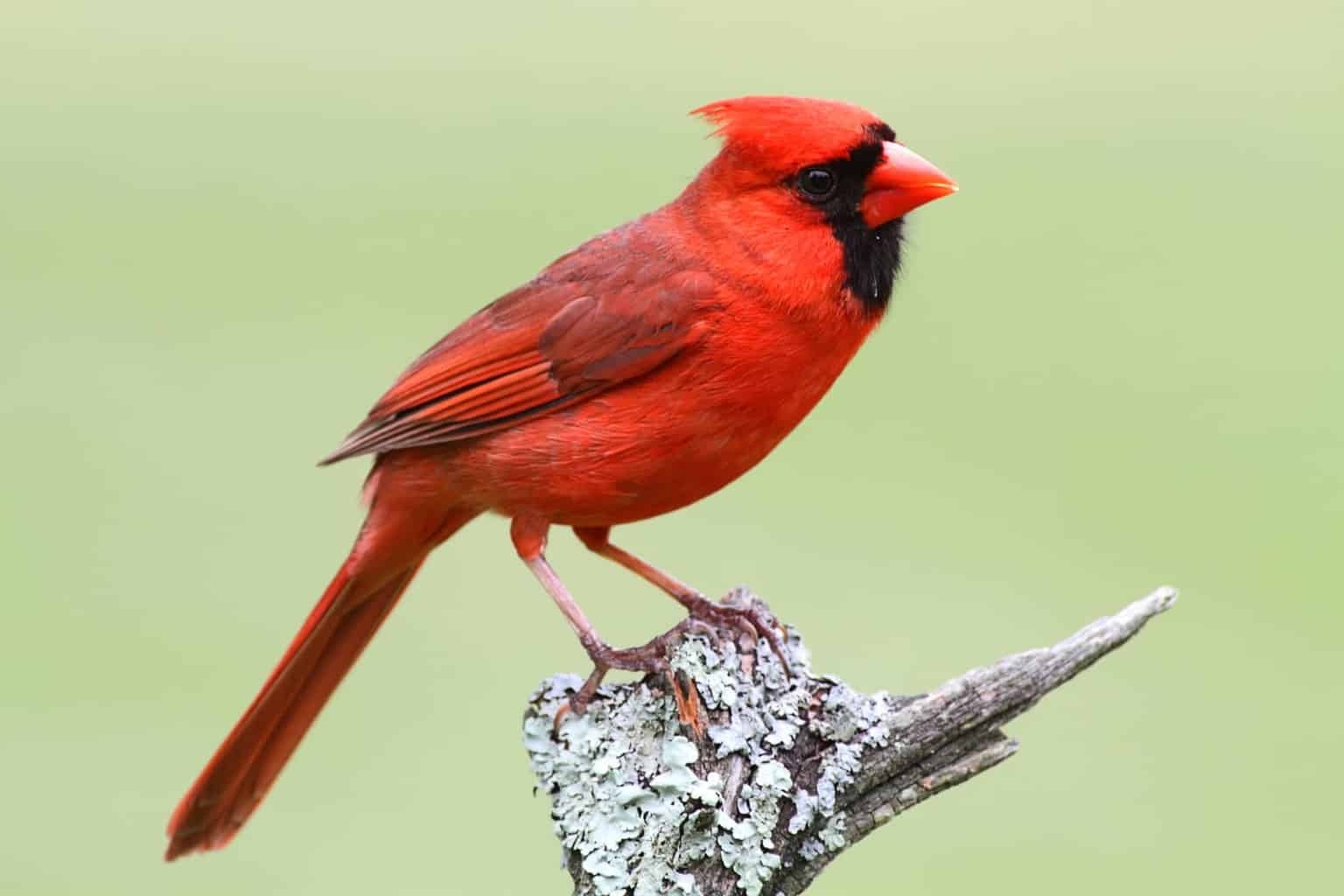
- Scientific Name: Cardinalis cardinalis
- Length: 7 – 9 inches
- Weight: 1.5 – 2 ounces
- Wingspan: 10 – 12 inches
Starting our list is Virginia’s official state bird: the Northern Cardinal. This bright ruby-red bird is one of the easiest to identify, even for those who don’t know much about birds.
One fascinating tidbit is that these birds are always preoccupied with defending their territories. In fact, they’re so obsessed that they sometimes charge at their own reflections.
Northern cardinals can be spotted year-round in woodlands, meadows, and gardens. They enjoy feeding on insects, berries, and seeds.
Red-Bellied Woodpecker

- Scientific Name: Melanerpes carolinus
- Length: 8 – 10 inches
- Weight: 2.5 – 3 ounces
- Wingspan: 15 – 17 inches
Red-bellied woodpeckers are easy to spot with their reddish-orange cap and nape. Their calls are also quite distinctive, especially in the spring.
These hard workers are year-round residents of Virginia’s forests and woods. They prefer areas with deadwood as it makes their pecking less difficult.
In the winter, a red-bellied woodpecker’s diet usually consists of plant matter. Then, when it gets warmer, it eats more fruits and seeds.
Rose-Breasted Grosbeak
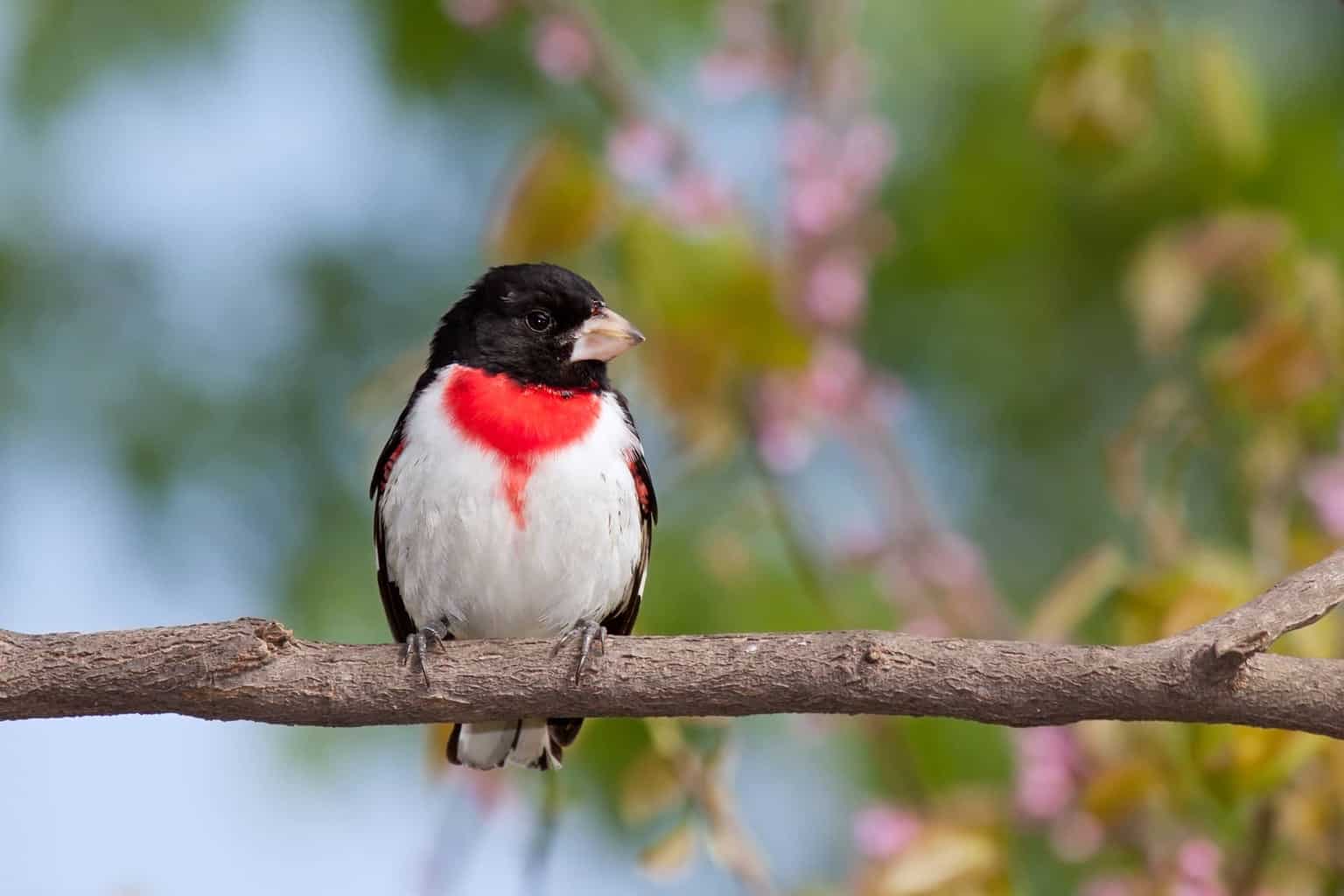
- Scientific Name: Pheucticus ludovicianus
- Length: 6 – 10 inches
- Weight: 0.1 – 0.2 ounce
- Wingspan: 10 – 14 inches
The Rose-breasted grosbeak has a striking red patch of feathers on its throat and upper chest. The head and back are streaked with black, while the underbelly is covered in white.
These medium-sized birds like snacking on sunflower seeds. They also feed on nuts and fruits.
They can be spotted in mountain regions and the coastal plain. If you can’t see them, you’ll be able to hear their clear yet intense song.
Ruby-Throated Hummingbird
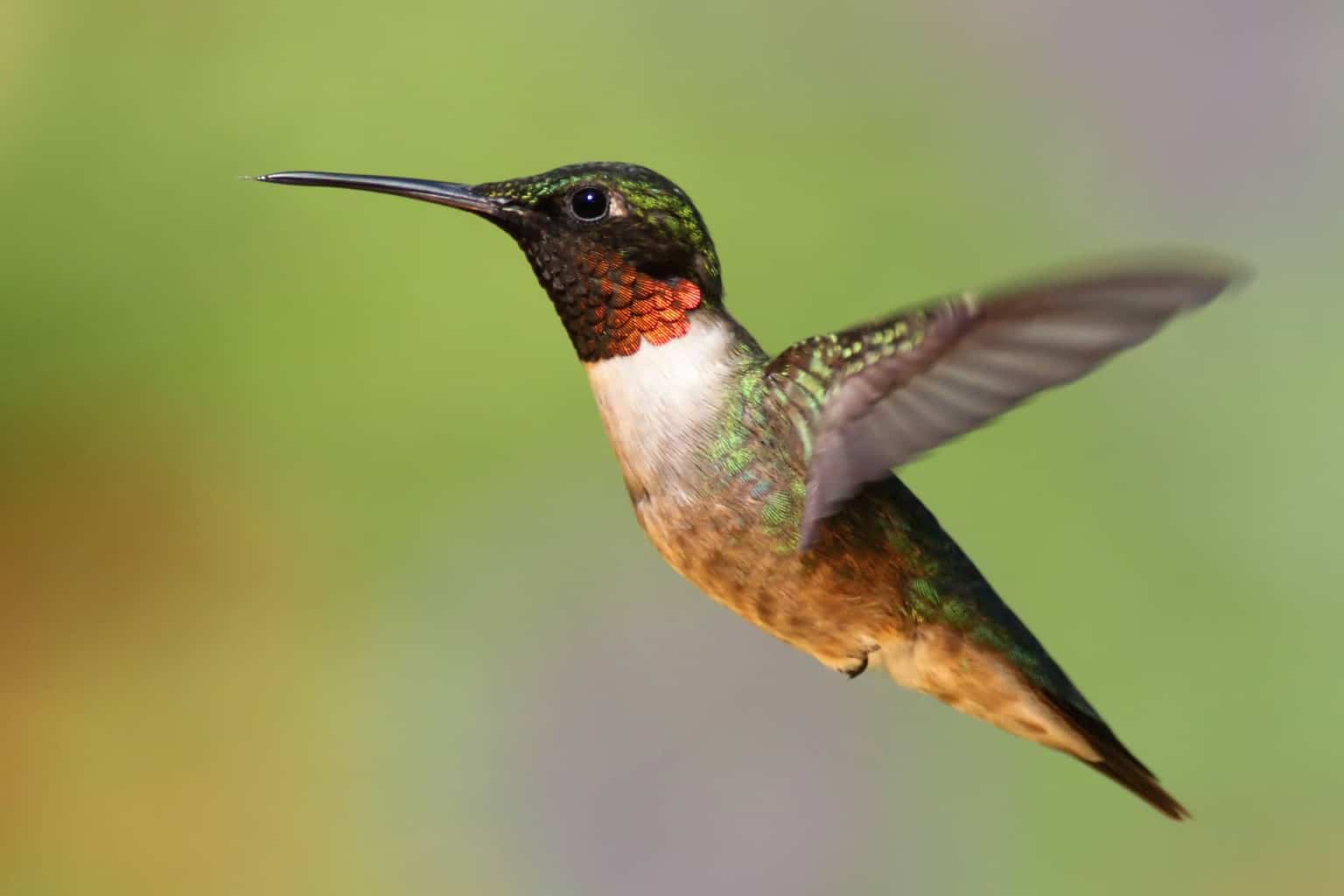
- Scientific Name: Archilochus colubris
- Length: 3 – 3.5 inches
- Weight: 0.1 – 0.2 ounce
- Wingspan: 3 – 4.5 inches
The Ruby-throated hummingbird is so small it can comfortably fit in the palm of your hand. They’re covered in an amazing mix of brilliant colors.
Their heads and throats are ruby-red. In direct contrast, their upperparts are a deep shade of metallic green that shimmers in the light.
You can typically spot them in Virginia during the summer. They’ll probably be hovering over flowers, sipping on nectar. Their diet also includes small insects, worms, and seeds.
Blue Birds in Virginia
Blue Jay
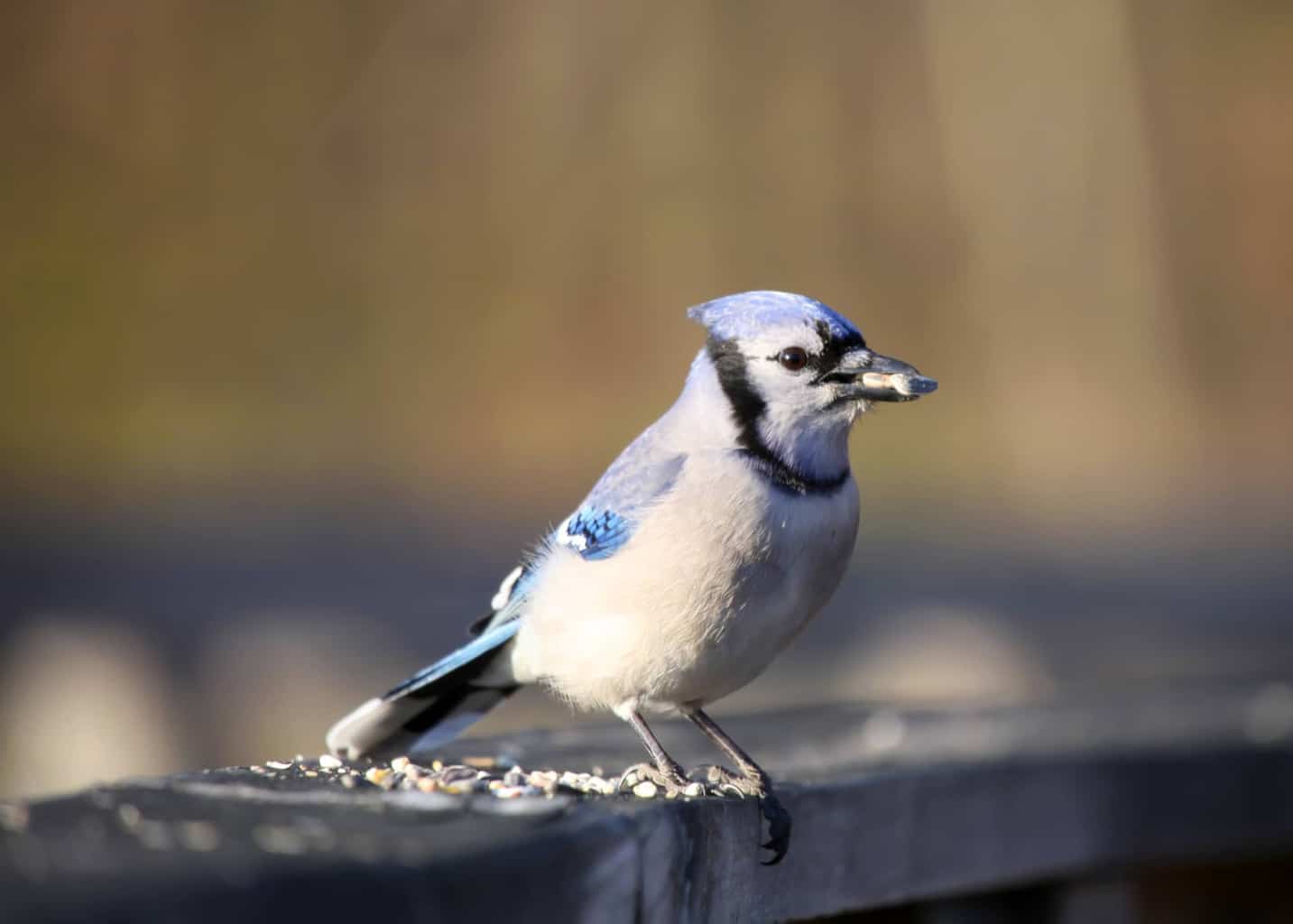
- Scientific Name: Cyanocitta cristata
- Length: 10 – 12 inches
- Weight: 2.5 – 4 ounces
- Wingspan: 13 – 17 inches
Blue jays are one of the more common year-round songbirds you’ll come across in Virginia. They tend to move in groups and can get quite boisterous when they’re all singing simultaneously.
Another way of identifying them is by their bright-colored plumage. Blue jays are covered in different shades of blue, while their undersides are grayish-white.
These colorful birds like to feed on seeds and nuts. You may also find them enjoying suet from your backyard bird feeder.
Cerulean Warbler
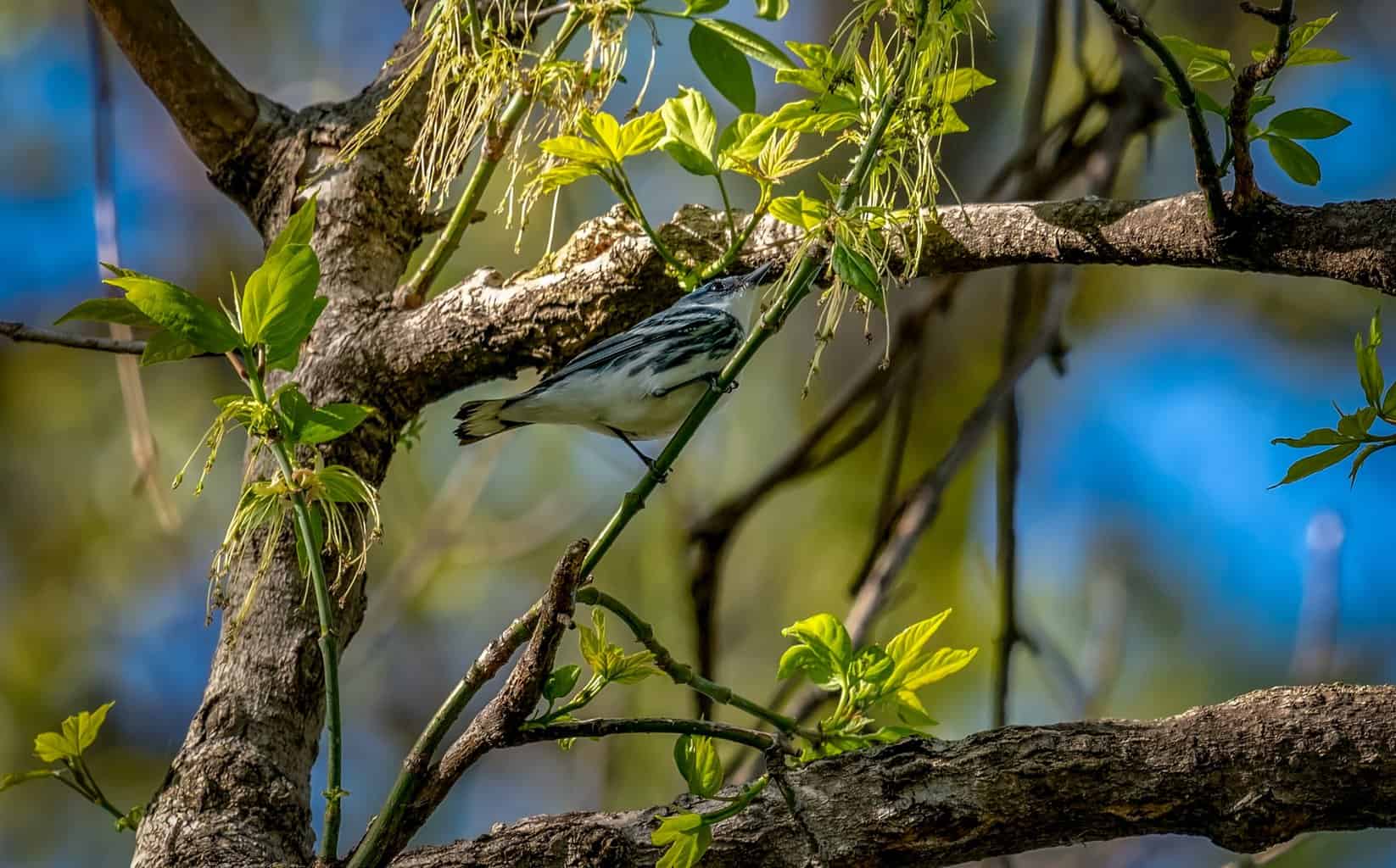
- Scientific Name: Setophaga cerulea
- Length: 3.5 – 4.5 inches
- Weight: 0.3 – 0.5 ounce
- Wingspan: 7 – 8 inches
The Cerulean Warbler is a small, adorable bird. Still, it has one of the most magnificent plumage colorings imaginable.
Its head and entire back are a motley of various shades of blues. The upper wings are also covered in the same colors but turn slightly gray near the tips.
You can see these birds in mountain regions or coastal plains during the summer. They generally tend to feed up high in the canopy of tulip poplar trees, where it’s safe from predators.
Eastern Bluebird

- Scientific Name: Sialia sialis
- Length: 5.5 – 8 inches
- Weight: 1 – 1.5 ounces
- Wingspan: 10 – 12.5 inches
Eastern bluebirds are small, lively creatures. Their exquisite coloring makes them easy to spot perching on posts, low branches, or in meadows.
Both males and females have blue caps, backs, and wings with rust-orange throats and chests. However, the male’s colors are much more prominent than the female’s.
These year-round residents love snacking on mealworms and other small insects. They also feed on nuts and seeds.
Peregrine Falcon

- Scientific Name: Falco peregrinus
- Length: 14 – 19.5 inches
- Weight: 19 – 56.5 ounces
- Wingspan: 39.5 – 43.5 inches
Believed by many to be the most regal of all birds of prey, the Peregrine falcon is easy to identify. Thanks to its aerodynamic flying, this bird is majestic yet extremely intimidating.
The Peregrine falcon is covered in dark plumage, which appears much paler in the light. The neck is white, which gives it a distinguishing appearance.
These fierce predators feed on smaller birds, such as shorebirds, rock doves, and waterfowl. You can spot them year-round along the Eastern shores, where they like to show off their smooth flying.
Green Birds in Virginia
Black-Throated Green Warbler
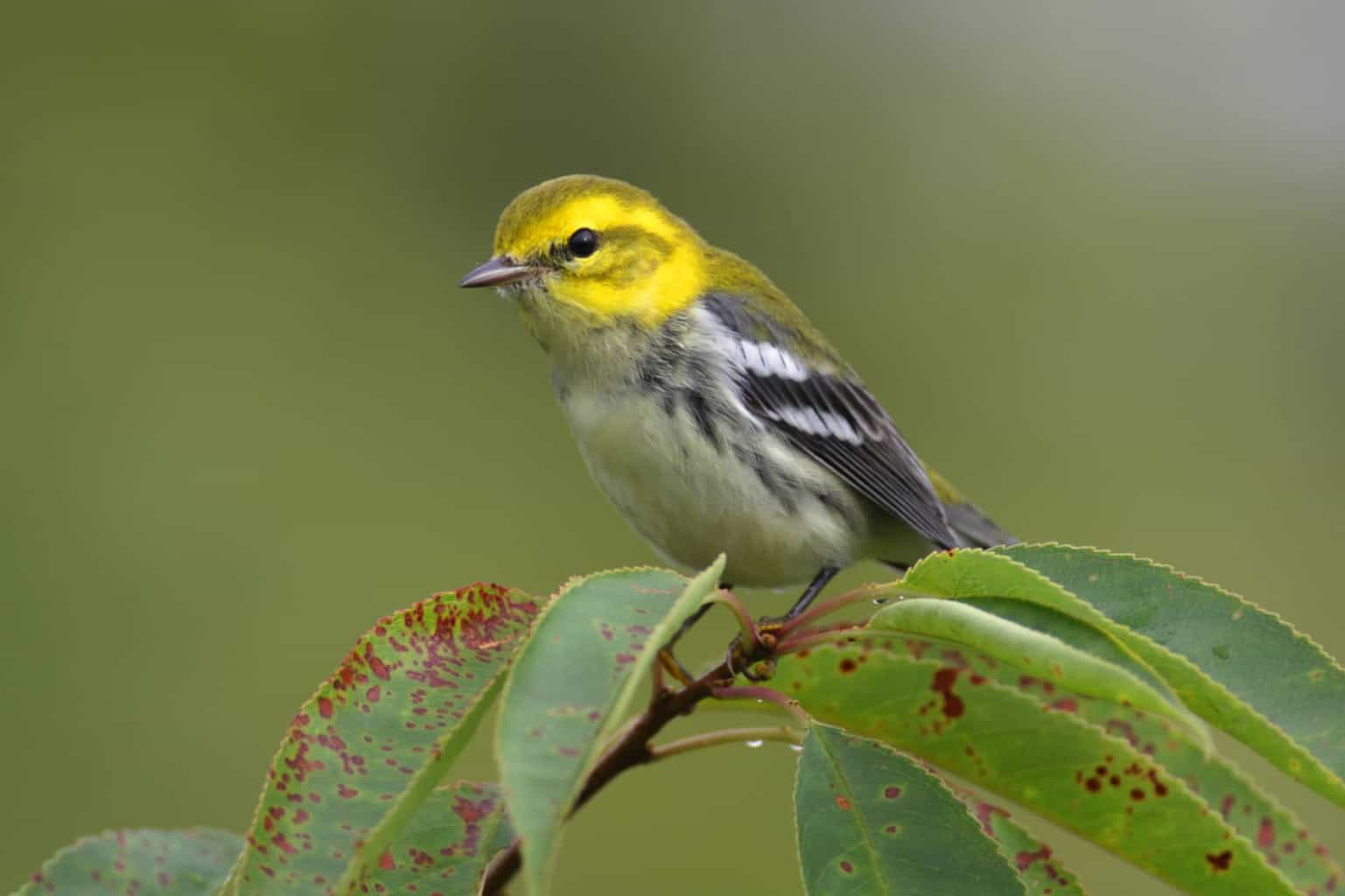
- Scientific Name: Setophaga virens
- Length: 4.5 – 5 inches
- Weight: 0.3 – 0.5 ounce
- Wingspan: 7 – 8 inches
Black-throated Green warblers are medium-sized birds that breed in the north. In winter, they head south to enjoy warm weather on Virginia’s coast.
The upperparts and crown are a rich shade of olive green streaked with black. White underparts create a nice contrast and make them easy to spot.
Their habitat consists of pine or hemlock forests. This is where they easily find food, which includes seeds, fruits, and insects.
Pine Warbler
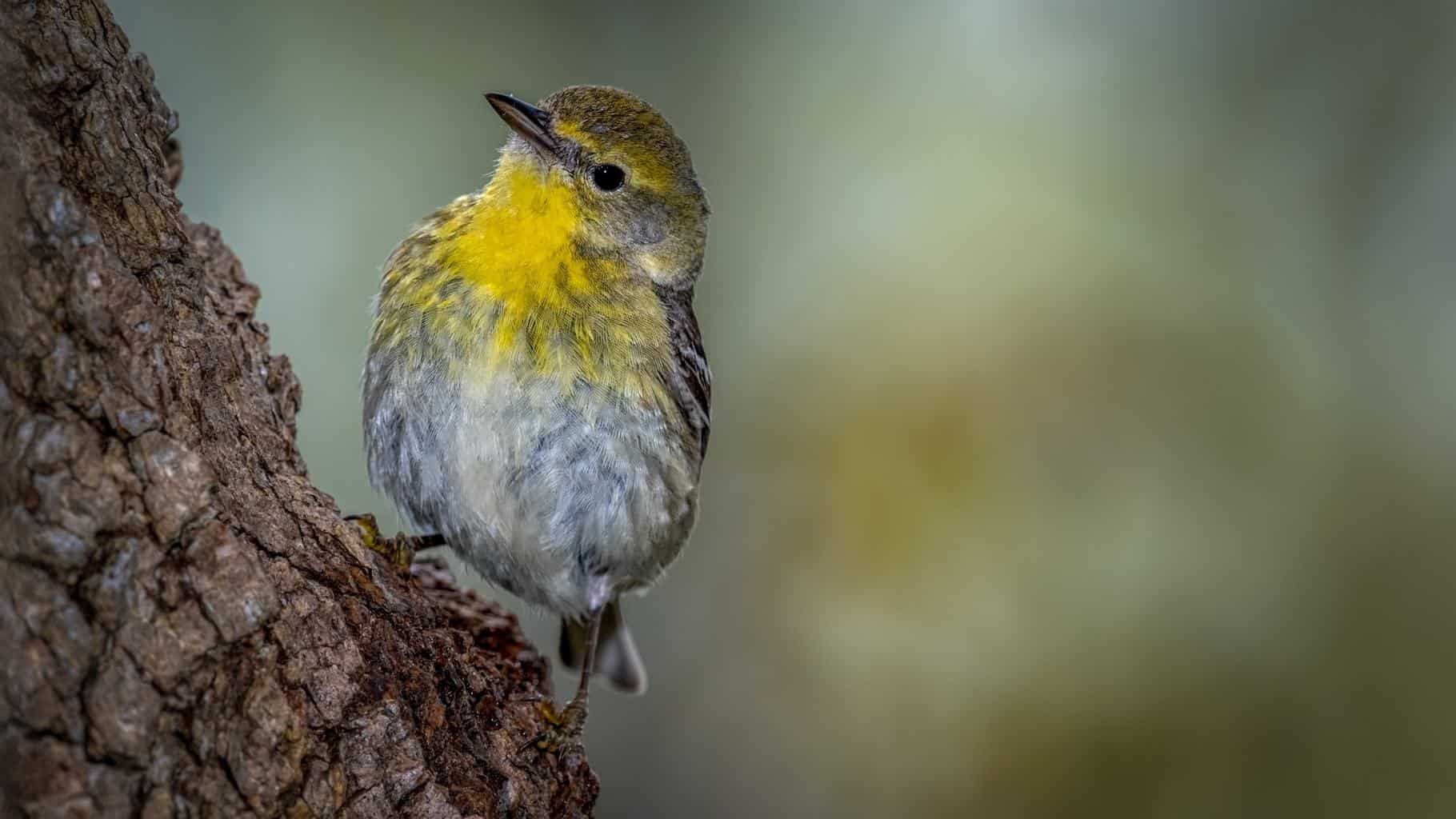
- Scientific Name: Setophaga pinus
- Length: 5.5 – 6 inches
- Weight: 0.5 – 1 ounce
- Wingspan: 8.5 – 10 inches
A medium-sized member of the warbler family, Pine Warblers have plain olive-green upperparts. Their wings and bellies are grayish-white.
These migratory birds spend their winters in Virginia. You can identify them by their notable musical call.
As their name indicates, they prefer setting up their nests in pine forests, where they can hide among the needles. It’s also where they can find the most food, as they typically forage in trees and nearby shrubs.
Townsend’s Warbler
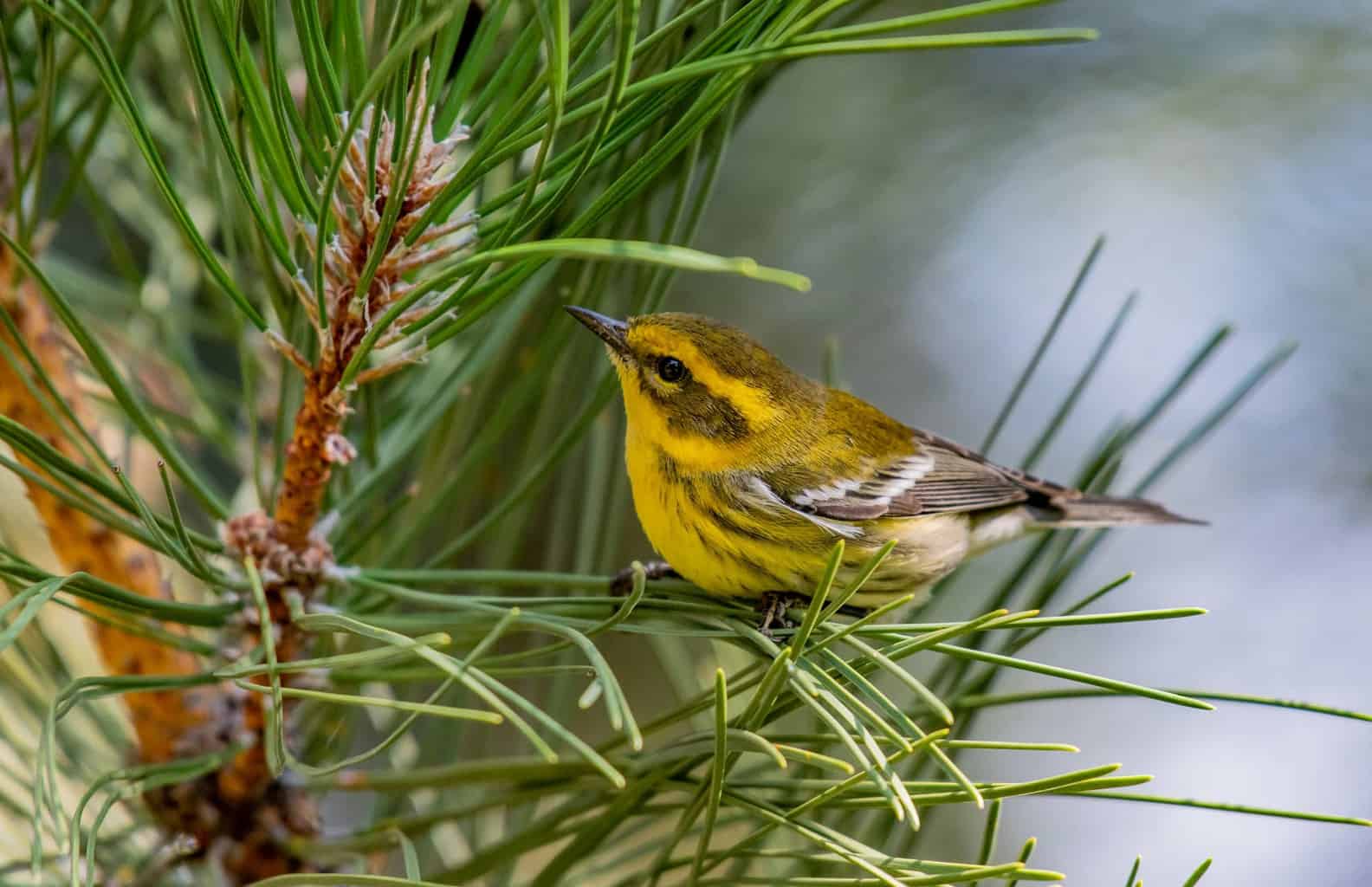
- Scientific Name: Setophaga townsendi
- Length: 4 – 5 inches
- Weight: 0.3 – 0.4 ounce
- Wingspan: 7.5 – 8.5 inches
Townsend’s warblers have olive-green upperparts. Their underparts are yellow and streaked with black and white.
These migratory birds find their way to Virginia in the winter. You can usually spot them in coniferous forests, especially Douglas firs.
Their diet consists of fruits, seeds, and nuts. They’re even capable of catching flying insects in mid-air.
Willow Flycatcher

- Scientific Name: Empidonax traillii
- Length: 6 – 7.5 inches
- Weight: 0.5 – 1.5 ounces
- Wingspan: 8 – 9 inches
Willow flycatchers are small-sized birds. Their upperparts have brown-olive green plumage, while their bellies and throats are white.
They spend summers in Virginia and prefer habitats like orchards, pastures, and thickets. You can also spot them perching near bodies of water, like streams and lakeshores.
The interesting thing about Willow flycatchers is that they forage at night. They feed on seeds, insects, and worms, which they’ll pick up straight from the foliage.
Orange Birds in Virginia
American Robin
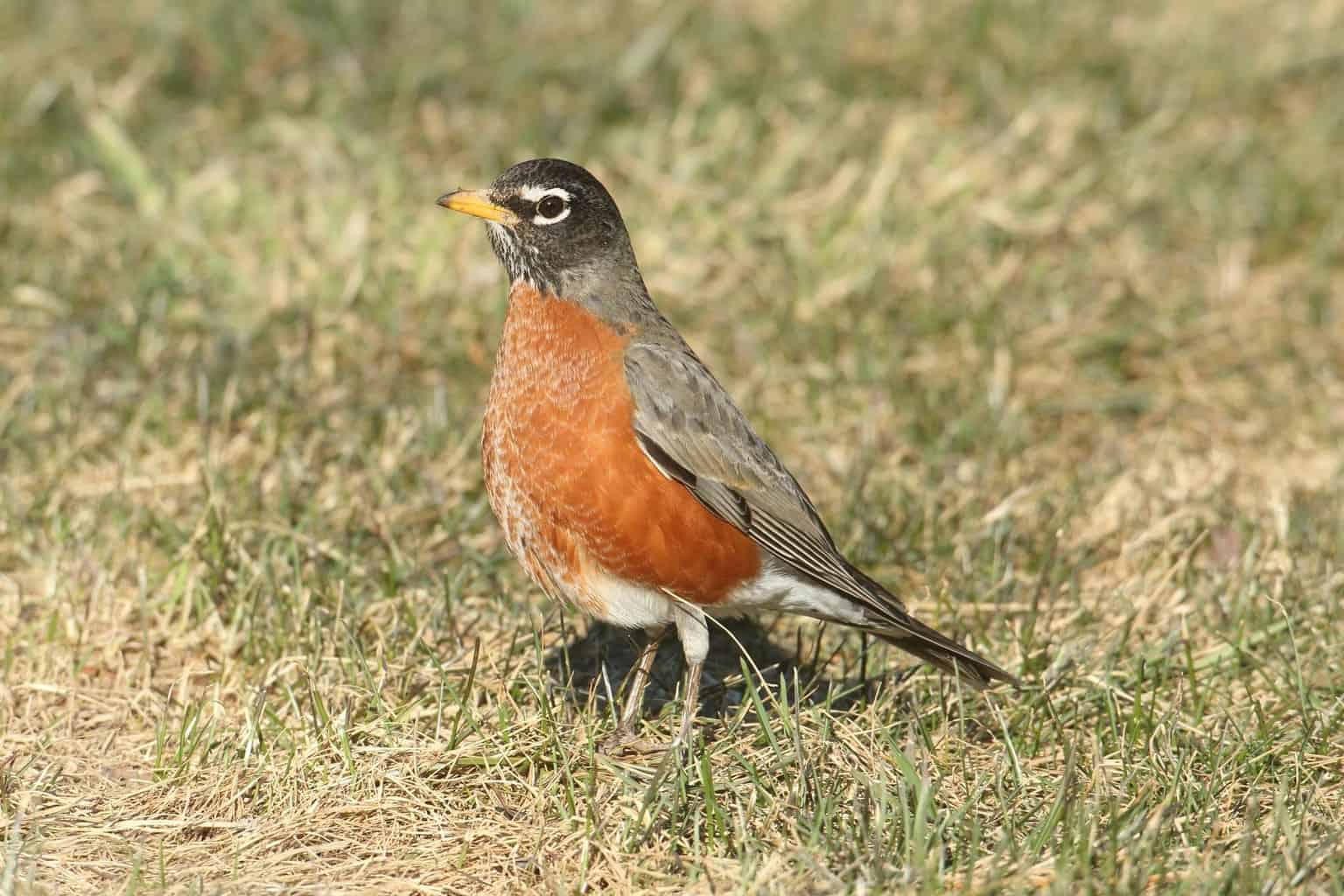
- Scientific Name: Turdus migratorius
- Length: 9 – 11 inches
- Weight: 1.5 – 3 ounces
- Wingspan: 12 – 16 inches
The American robin has stunning bright orange plumage that runs from the chin to the rump. Its cap, back, and wings are covered in various shades of brown, grey, and black.
These birds enjoy hanging out year-round in Virginia’s fields and deciduous forests. They’re accustomed to being around humans, so they may pop in for an afternoon visit to your birdfeeder.
If you do have a birdfeeder, add some sunflower seeds, raisins, and a couple of apple slices. If not, American robins typically feed on earthworms, mealworms, and other insects.
Baltimore Oriole
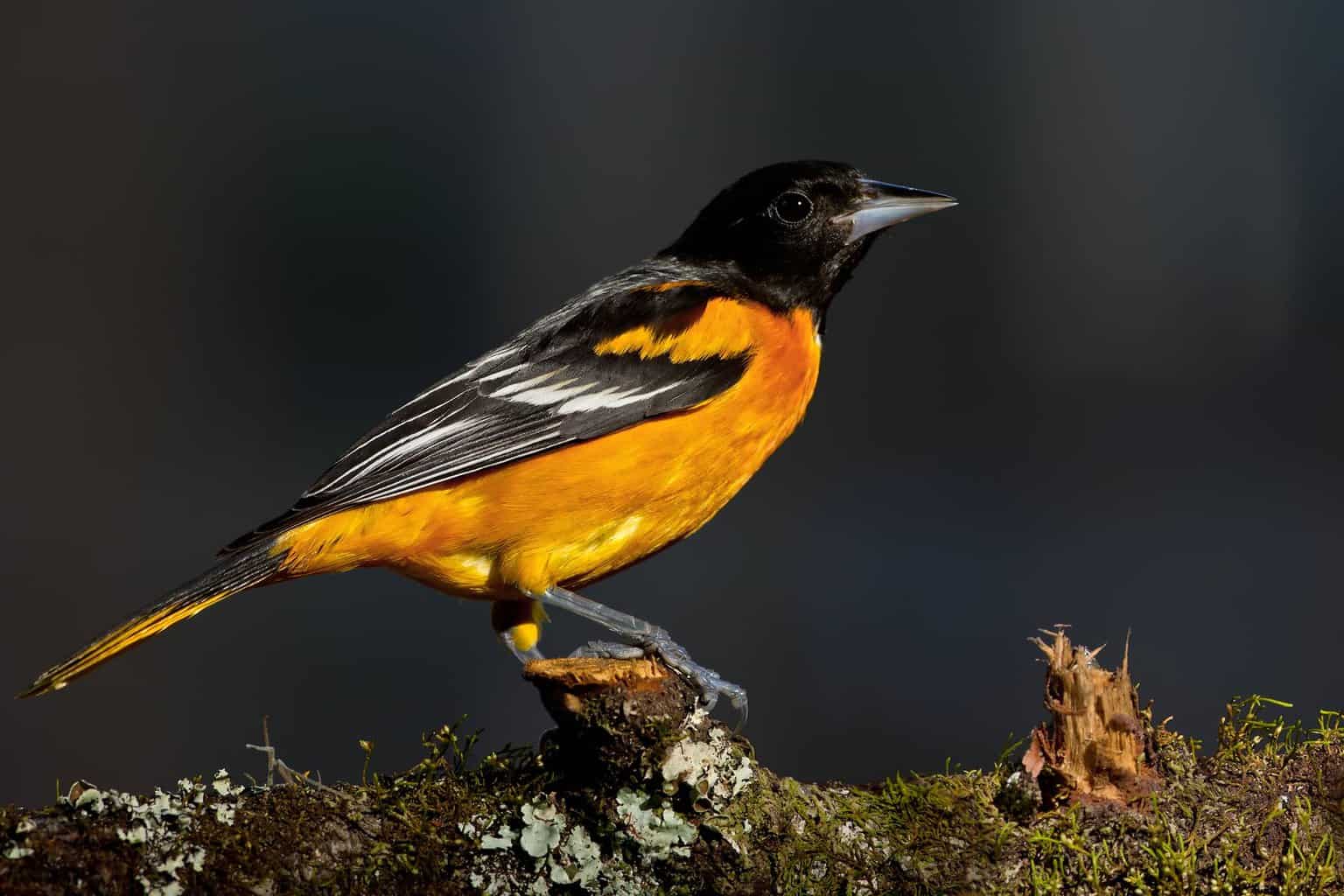
- Scientific Name: Icterus galbula
- Length: 6 – 8 inches
- Weight: 1 – 1.5 ounces
- Wingspan: 9 – 12 inches
The Baltimore oriole is one impressive songbird. It has bright orange plumage that runs from the throat to the rump.
It’s also pretty big. So, between its bright color and large size, you’ll be able to spot it easily.
Make sure you look for this oriole in the mountains of Virginia, especially in the northern parts of the state. They set up their habitats in deciduous trees, where seeds and nuts are abundant.
Barn Swallow

- Scientific Name: Hirundo rustica
- Length: 6 – 7.5 inches
- Weight: 0.5 – 1 ounce
- Wingspan: 13 – 14 inches
Barn swallows are characterized by their short, straight black bills. Yet, the orange covering their breasts, underwings, and faces really grabs your attention.
These small birds can be spotted in fields and parks during winter. They also like being near water, so you may come across them near ponds or marshes.
Their diet consists of nuts, berries, and insects. They’re social birds and may visit your backyard feeder to grab some lunch.
Say’s Phoebe

- Scientific Name: Saynornis saya
- Length: 7 – 7.5 inches
- Weight: 0.5 – 1 ounce
- Wingspan: 11 – 12.5 inches
Say’s phoebe is a medium-sized flycatcher that spends time in Virginia during its migration. It has a weak flutter with limited wing beats.
These dainty birds have grayish-orange bellies. Their upper wings are dark brown, while their underwings have orange plumage.
You can catch them foraging in open fields, such as farmlands and prairies. Their preferred food is insects, but they’ll also snack on seeds and berries.
Yellow Birds in Virginia
American Goldfinch

- Scientific Name: Spinus tristis
- Length: 4 – 5.5 inches
- Weight: 0.5 – 1 ounce
- Wingspan: 7.5 –9 inches
In the spring, male American goldfinches are covered in rich yellow plumage to attract the females. Then, in winter, the yellow becomes a dull brown.
American goldfinches are year-round residents of Virginia. They can be spotted in suburban areas and orchards.
These attractive little birds like feeding on seeds, maple sap, and insects. If you’ve planted milkweed or asters, you may find a couple of American goldfinches in your backyard.
Prothonotary Warbler
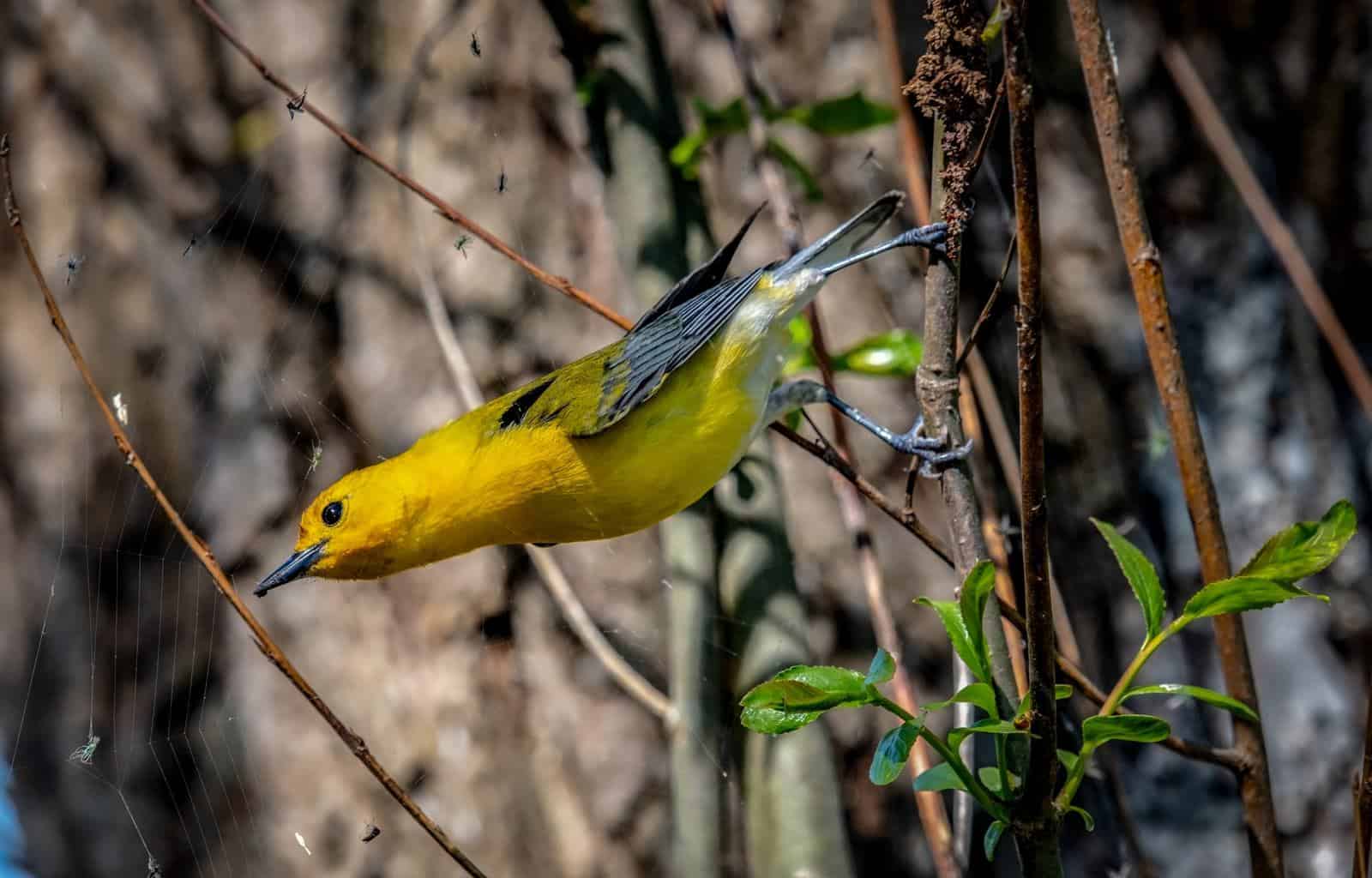
- Scientific Name: Protonotaria citrea
- Length: 5 – 5.5 inches
- Weight: 12 – 12.5 ounces
- Wingspan: 8 – 9 inches
Cute and charming, a Prothonotary warbler is a medium-sized, sweet-sounding bird. Its bright yellow underparts, head, and neck easily give it away.
You can find them in forests. They also prefer to be near water, so you may spot them near wooded swamps and streams with deadwood.
Their diet mainly consists of insects. In addition, these lively warblers like feeding on fruits and seeds they find while foraging on the ground.
Yellow-Crowned Night Heron

- Scientific Name: Nyctanassa violacea
- Length: 21.5 – 27.5 inches
- Weight: 22 – 28 ounces
- Wingspan: 42 – 44 inches
The yellow-crowned night heron is mostly gray with mottled wings. Although, the bright flash of yellow plumage on its crown makes it stand out. Even its legs and feet are yellow, which is rare.
These elegant birds prefer perching in thickets near the coast and wooded swamps. You can find them during the winter along the coast of Virginia.
They typically forage in open water, mainly in search of crustaceans. They also fish, reptiles, amphibians, and insects.
Western Tanager
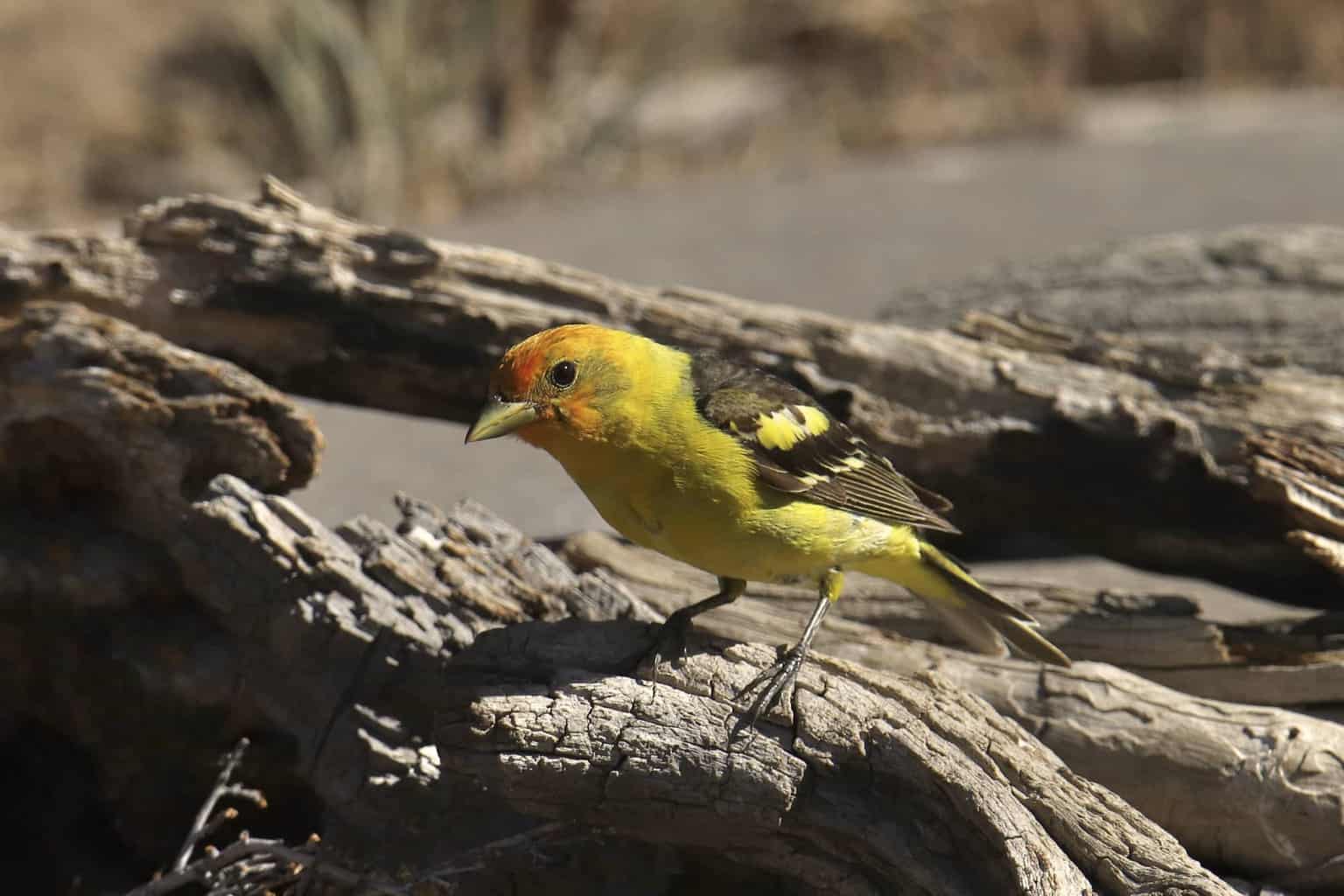
- Scientific Name: Piranga ludoviciana
- Length: 6 – 7.5 inches
- Weight: 1 – 1.5 ounces
- Wingspan: 10 – 11.5 inches
Western tanagers pass through Virginia during migration. These colorful birds are known for their bright yellow bellies and backs.
An interesting feature of this songbird is that it may start showing red streaks on its head. This isn’t their natural color but rather a pigmentation that appears due to the type of food they eat.
These songbirds forage in trees for berries and nuts. They’re also able to catch insects in mid-flight.
Black Birds in Virginia
Osprey

- Scientific Name: Pandion haliaetus
- Length: 22 – 25 inches
- Weight: 60 – 64 ounces
- Wingspan: 54 – 72 inches
Ospreys are fascinating raptors. Their outer toes are reversible for a better grip on their prey and more balance as they perch.
Another fascinating feature is their diet, which is made up almost entirely of live fish. In fact, it’s the only bird of prey that dines exclusively on live fish.
These large birds enjoy the warm winters of Virginia before moving on to the north in the summer. When in Virginia, you can spot them near bodies of water, like rivers, ponds, and salt-water marshes.
Lark Bunting

- Scientific Name: Calamospiza melanocorys
- Length: 5.5 – 7 inches
- Weight: 1 – 1.5 ounces
- Wingspan: 10 – 11 inches
Lark buntings are a type of medium to large-sized sparrow. They’re covered in black, except for a few white patches on their wings.
They stop in Virginia on their migratory route. Once there, you can see them walking or hopping in open areas and short grass prairies as they’re foraging.
Their diet includes seeds and nuts. They also eat insects, like ants, grasshoppers, and beetles.
Brown Birds
Carolina Wren
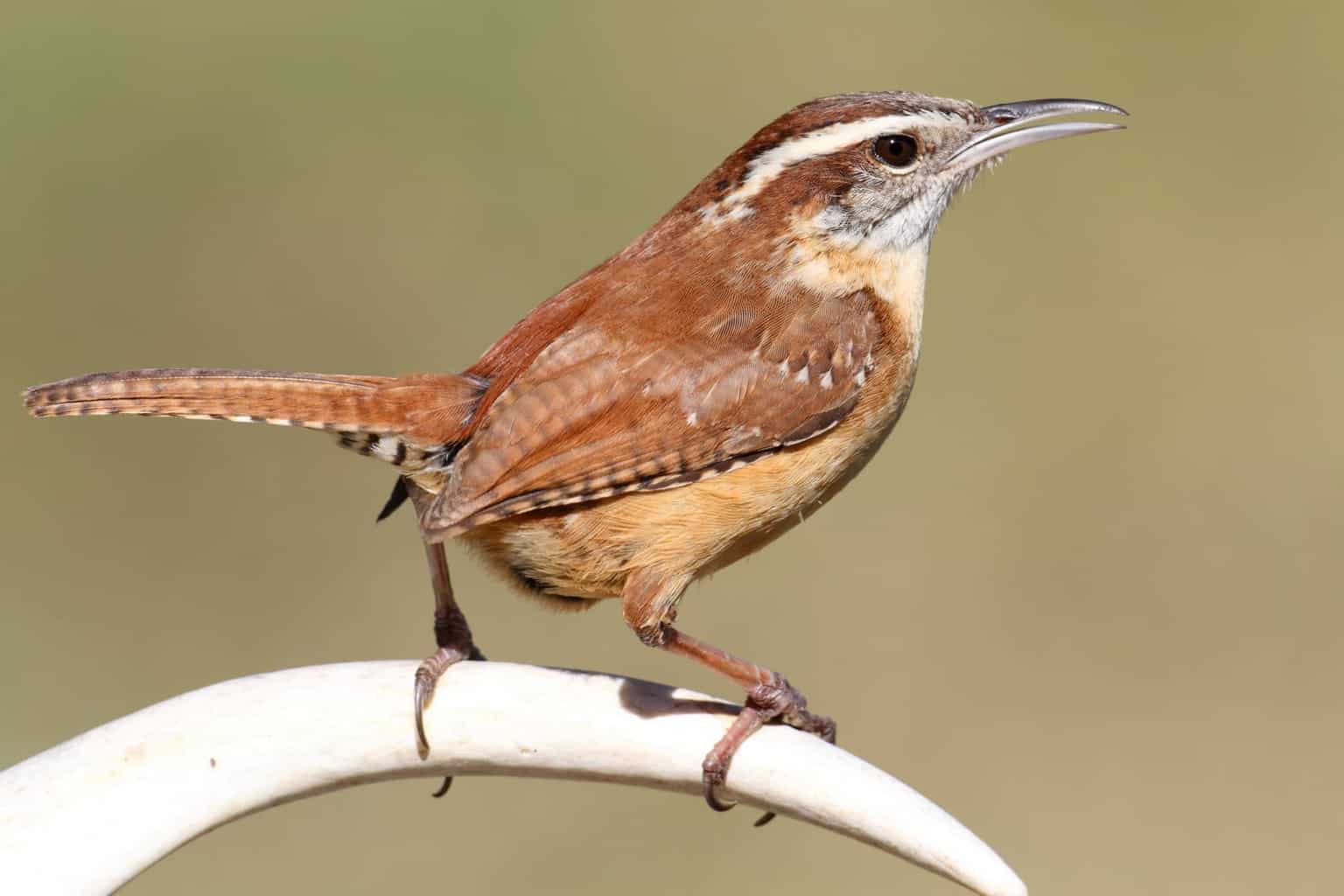
- Scientific Name: Thryothorus ludovicianus
- Length: 4.5 – 5.5 inches
- Weight: 0.5 – 1 ounces
- Wingspan: 10 – 11.5 inches
Carolina wrens are year-round residents of Virginia. They’re usually found in forests and brushy suburban areas.
These small-sized birds are covered in different shades of brown and buff. Their only special feature is their white eyebrow line.
Despite their modest size, they can get pretty loud. Yet, that doesn’t seem to scare away their prey, which includes a mix of spiders and insects.
Glossy Ibis
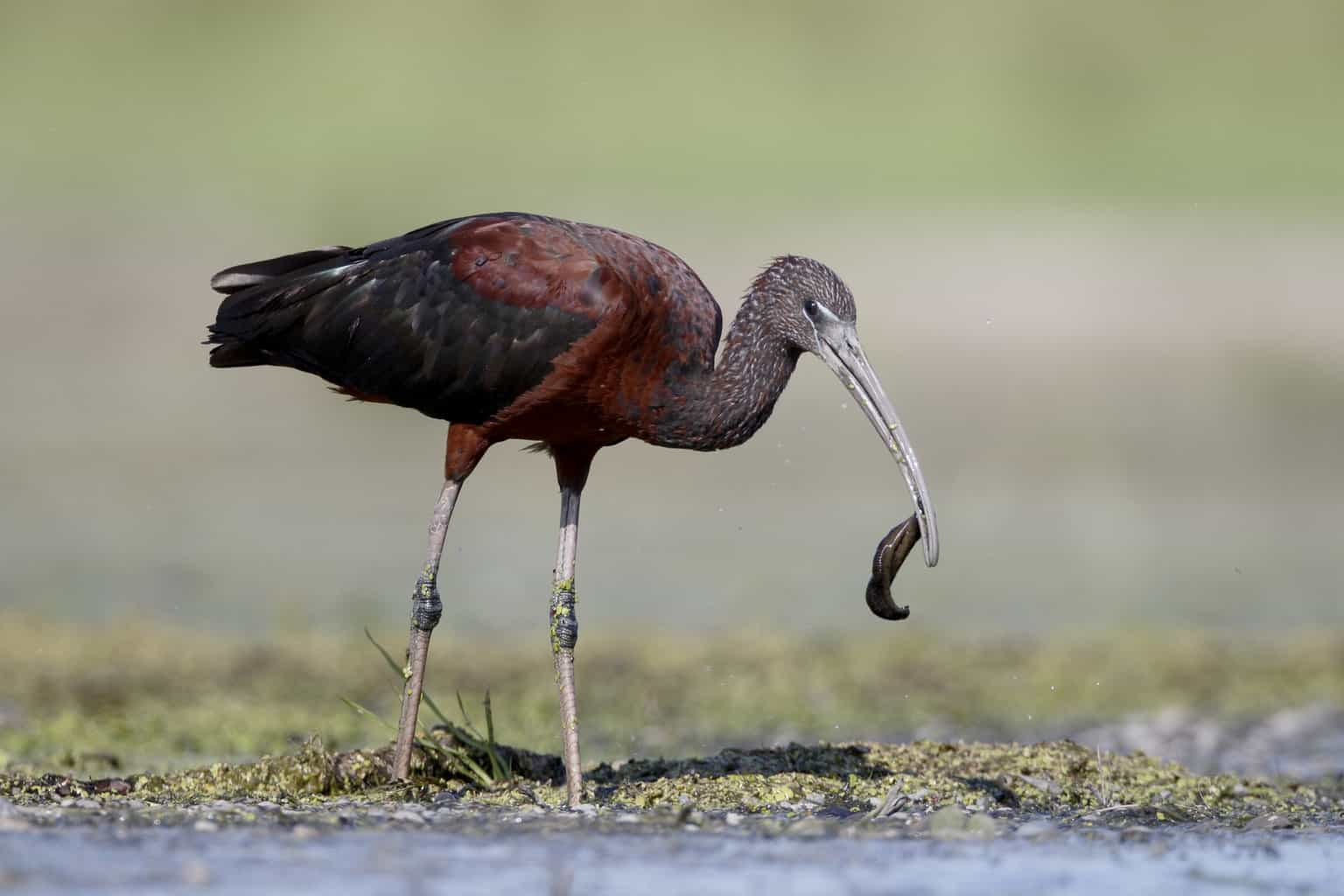
- Scientific Name: Plegadis falcinellus
- Length: 23 – 26 inches
- Weight: 19 – 22 ounces
- Wingspan: 30 – 36 inches
The Ibis is famous for its curved bill and glossy brown plumage. They’re typically found in Virginia’s wetlands and marshes during the winter.
They like to gather in flocks around the coast and the southern parts of the state. Though the best place to guarantee an Ibis spotting is the Chincoteague National Wildlife Refuge.
Ibis prefer feeding in shallow water where they submerge their bills in search of prey. Their favorite food is invertebrates and fish.
Gray Birds
American Oystercatcher
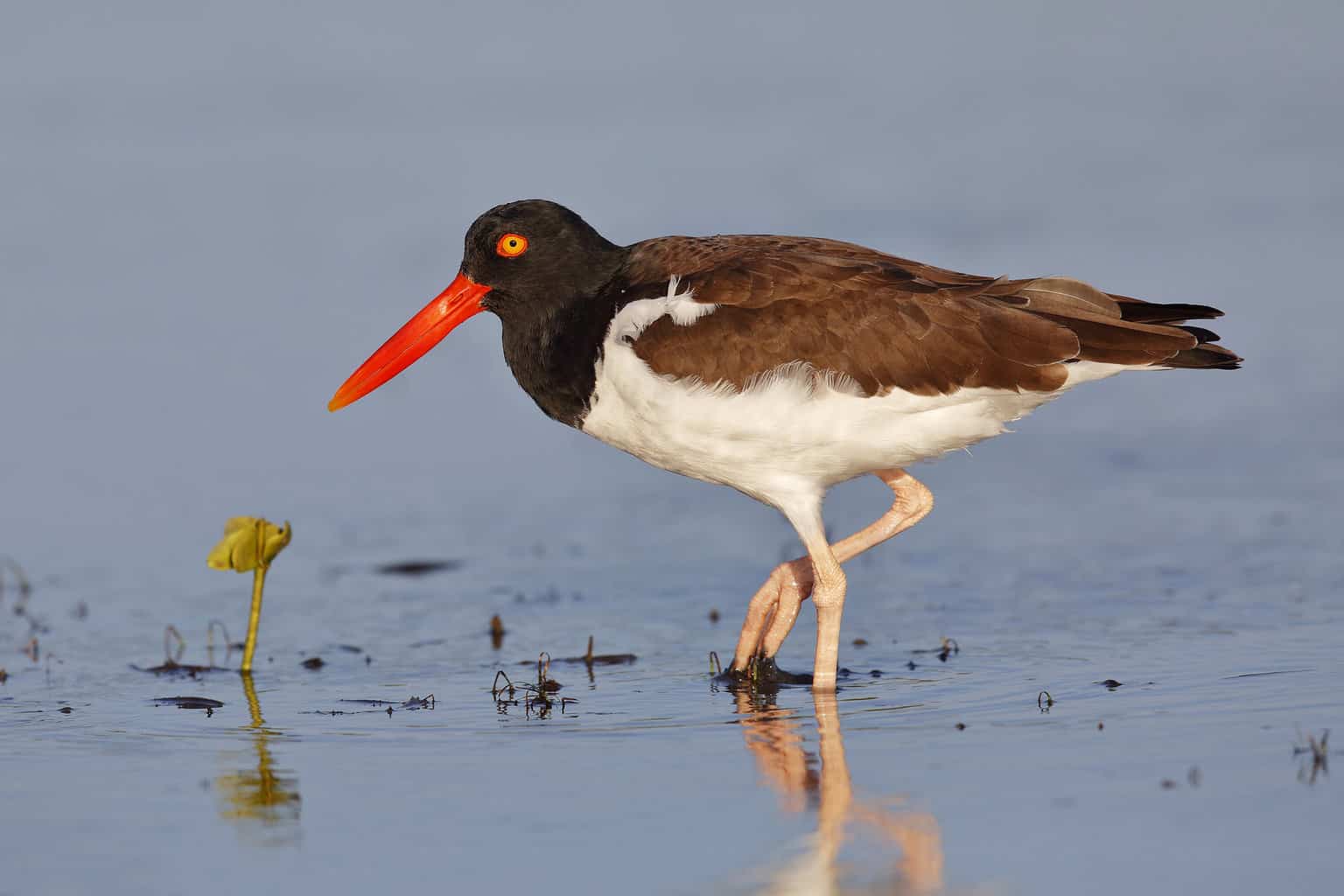
- Scientific Name: Haematopus palliatus
- Length: 16 – 17 inches
- Weight: 14 – 25 ounces
- Wingspan: 30 – 35 inches
You can easily identify the American oystercatcher, thanks to its bright red bill and eyes. Its light pink legs are another special characteristic.
This large shorebird has a dark grey head and neck. Its back and upper wings are also grey, but a slightly lighter shade.
Typically seen near the Eastern shore, these year-round residents prefer feeding on mollusks. It uses its powerful bill to open the shell and start snacking.
Cooper’s Hawk
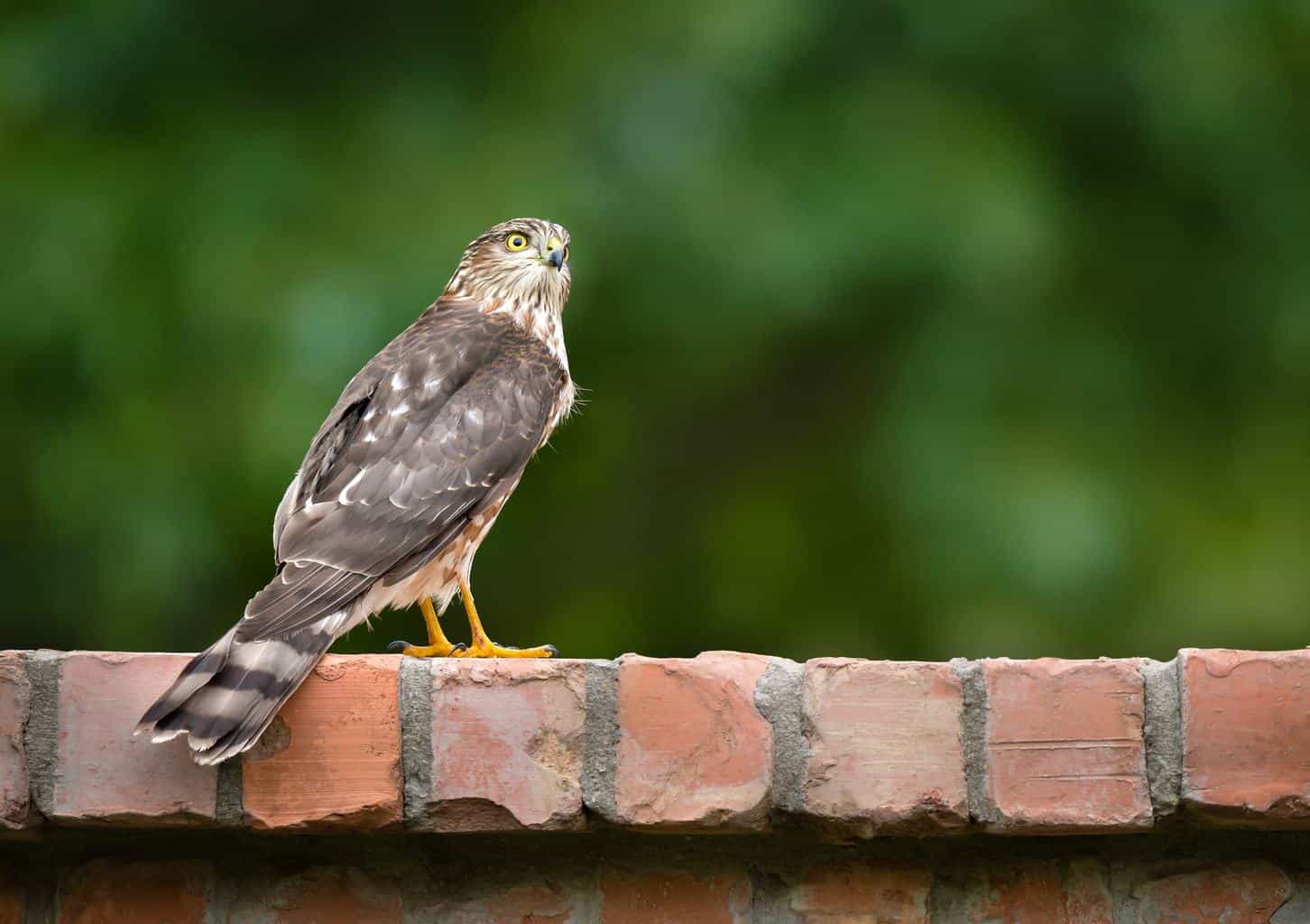
- Scientific Name: Accipiter cooperii
- Length: 14 – 29 inches
- Weight: 8 – 24 ounces
- Wingspan: 29 – 37 inches
Cooper’s hawks are known for their silent but deadly flying. They spend almost all their time soaring overhead in search of food.
They can be found year-round in Virginia, typically in woodlands and deciduous forests. You can identify them by their all-gray upperparts, pale bellies, and red eyes.
To keep up their energy levels, these raptors feed on rodents, smaller birds, and mammals. They’ve also been known to sneak up on songbirds as they snack away in backyard feeders.
Iridescent Birds
Common Grackle

- Scientific Name: Quiscalus quiscula
- Length: 11 – 13 inches
- Weight: 2.5 – 5 ounces
- Wingspan: 14 – 18 inches
From far away, it appears this bird is black all over like the typical blackbird should be. Then, when the light is at just the right angle, all these glossy, iridescent colors begin to appear.
These shimmery blackbirds mostly eat crops. They’ll also snack on seeds, grain, and fruits.
You can spot them year-round perching on tall tree branches or billboard signs. As a flock, they can be noisy, so make sure you keep your ears on high alert.
Groove-Billed Ani

- Scientific Name: Crotophaga sulcirostris
- Length: 10 – 13 inches
- Weight: 2.5 – 3.5 ounces
- Wingspan: 16 –18 inches
One of the first things you’ll notice about the Groove-billed ani is its long tail. The other noteworthy feature is its iridescent plumage.
These shimmery birds set up their habitat in half-open fields, such as thickets and woodland edges. They tend to avoid unbroken woodlands and forests.
They feed on berries, fruits, and seeds. They’re also known to fly close to the ground to catch insects, spiders, and even lizards.
White Birds
Tundra Swan

- Scientific Name: Cygnus columbianus
- Length: 50 – 55 inches
- Weight: 224 – 256 ounces
- Wingspan: 80 – 85 inches
One of the largest native waterfowls of Virginia, the Tundra swan has a long, sleek neck and striking white plumage. They can also be identified by their high-pitched hoots.
These migratory birds arrive in Virginia by November and stay until the middle of March. Then, they migrate by the hundreds in a bevy that resembles a V-formation.
During the cold months, these graceful birds can be found near the coast, bay areas, and marshes. They prefer feeding in estuaries and shallow ponds.
White-Breasted Nuthatch
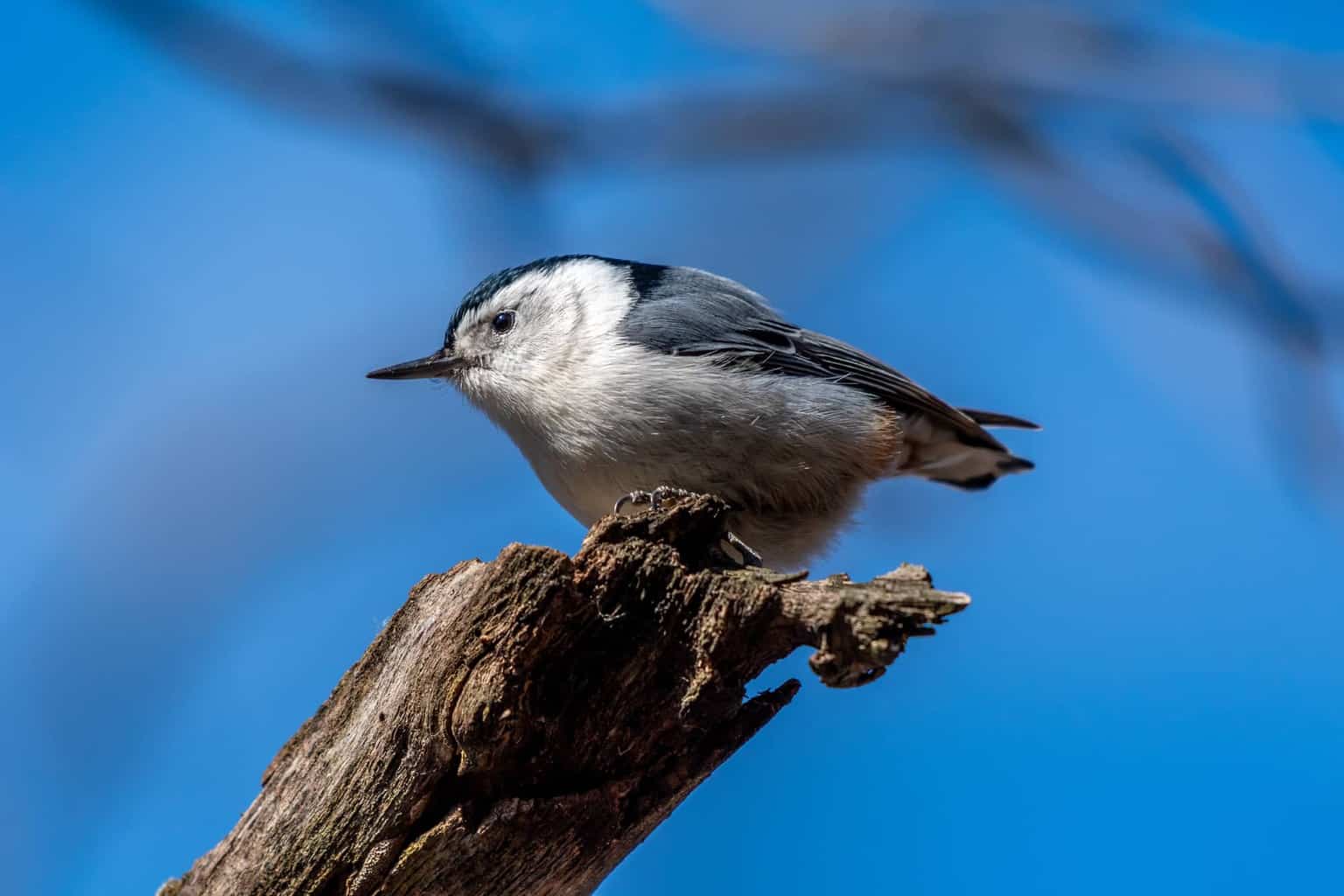
- Scientific Name: Sitta carolinensis
- Length: 5 – 5.5 inches
- Weight: 0.6 – 1.1 ounces
- Wingspan: 8 – 11 inches
White-breasted nuthatches are small but very active birds. To get the energy they need, their diet consists of fruits and small insects.
They remove the nuts from their shells by jamming them into the bark of a tree. Then, they strike the shells with their bills to crack them open.
These year-round Virginians have white plumage on their faces and bellies. Their caps are black, whereas their backs and upper wings are grayish-blue.
Conclusion
We hope you enjoyed our list of some of the most spectacular birds in Virginia. So, the next time you’re passing through, make sure you take along our guide. Even if you’re not a real birdwatcher, you’ll be glad you didn’t miss out on any of these beautiful creatures.

